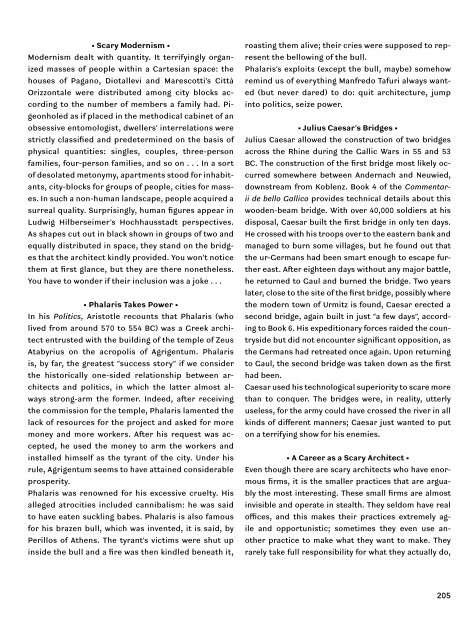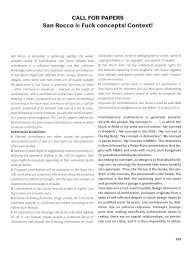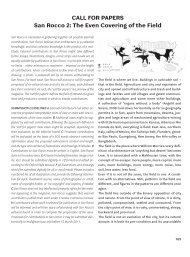CALL FOR PAPERS San Rocco 5: Scary Architects
CALL FOR PAPERS San Rocco 5: Scary Architects
CALL FOR PAPERS San Rocco 5: Scary Architects
Create successful ePaper yourself
Turn your PDF publications into a flip-book with our unique Google optimized e-Paper software.
• <strong>Scary</strong> Modernism •<br />
Modernism dealt with quantity. It terrifyingly organized<br />
masses of people within a Cartesian space: the<br />
houses of Pagano, Diotallevi and Marescotti’s Città<br />
Orizzontale were distributed among city blocks according<br />
to the number of members a family had. Pigeonholed<br />
as if placed in the methodical cabinet of an<br />
obsessive entomologist, dwellers’ interrelations were<br />
strictly classified and predetermined on the basis of<br />
physical quantities: singles, couples, three-person<br />
families, four-person families, and so on . . . In a sort<br />
of desolated metonymy, apartments stood for inhabitants,<br />
city-blocks for groups of people, cities for masses.<br />
In such a non-human landscape, people acquired a<br />
surreal quality. Surprisingly, human figures appear in<br />
Ludwig Hilberseimer’s Hochhausstadt perspectives.<br />
As shapes cut out in black shown in groups of two and<br />
equally distributed in space, they stand on the bridges<br />
that the architect kindly provided. You won’t notice<br />
them at first glance, but they are there nonetheless.<br />
You have to wonder if their inclusion was a joke . . .<br />
• Phalaris Takes Power •<br />
In his Politics, Aristotle recounts that Phalaris (who<br />
lived from around 570 to 554 BC) was a Greek architect<br />
entrusted with the building of the temple of Zeus<br />
Atabyrius on the acropolis of Agrigentum. Phalaris<br />
is, by far, the greatest “success story” if we consider<br />
the historically one-sided relationship between architects<br />
and politics, in which the latter almost always<br />
strong-arm the former. Indeed, after receiving<br />
the commission for the temple, Phalaris lamented the<br />
lack of resources for the project and asked for more<br />
money and more workers. After his request was accepted,<br />
he used the money to arm the workers and<br />
installed himself as the tyrant of the city. Under his<br />
rule, Agrigentum seems to have attained considerable<br />
prosperity.<br />
Phalaris was renowned for his excessive cruelty. His<br />
alleged atrocities included cannibalism: he was said<br />
to have eaten suckling babes. Phalaris is also famous<br />
for his brazen bull, which was invented, it is said, by<br />
Perillos of Athens. The tyrant’s victims were shut up<br />
inside the bull and a fire was then kindled beneath it,<br />
roasting them alive; their cries were supposed to represent<br />
the bellowing of the bull.<br />
Phalaris’s exploits (except the bull, maybe) somehow<br />
remind us of everything Manfredo Tafuri always wanted<br />
(but never dared) to do: quit architecture, jump<br />
into politics, seize power.<br />
• Julius Caesar’s Bridges •<br />
Julius Caesar allowed the construction of two bridges<br />
across the Rhine during the Gallic Wars in 55 and 53<br />
BC. The construction of the first bridge most likely occurred<br />
somewhere between Andernach and Neuwied,<br />
downstream from Koblenz. Book 4 of the Commentarii<br />
de bello Gallico provides technical details about this<br />
wooden-beam bridge. With over 40,000 soldiers at his<br />
disposal, Caesar built the first bridge in only ten days.<br />
He crossed with his troops over to the eastern bank and<br />
managed to burn some villages, but he found out that<br />
the ur-Germans had been smart enough to escape further<br />
east. After eighteen days without any major battle,<br />
he returned to Gaul and burned the bridge. Two years<br />
later, close to the site of the first bridge, possibly where<br />
the modern town of Urmitz is found, Caesar erected a<br />
second bridge, again built in just “a few days”, according<br />
to Book 6. His expeditionary forces raided the countryside<br />
but did not encounter significant opposition, as<br />
the Germans had retreated once again. Upon returning<br />
to Gaul, the second bridge was taken down as the first<br />
had been.<br />
Caesar used his technological superiority to scare more<br />
than to conquer. The bridges were, in reality, utterly<br />
useless, for the army could have crossed the river in all<br />
kinds of different manners; Caesar just wanted to put<br />
on a terrifying show for his enemies.<br />
• A Career as a <strong>Scary</strong> Architect •<br />
Even though there are scary architects who have enormous<br />
firms, it is the smaller practices that are arguably<br />
the most interesting. These small firms are almost<br />
invisible and operate in stealth. They seldom have real<br />
offices, and this makes their practices extremely agile<br />
and opportunistic; sometimes they even use another<br />
practice to make what they want to make. They<br />
rarely take full responsibility for what they actually do,<br />
205




